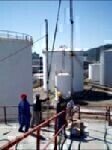Water/Wastewater
Contaminated Tank Storage
Oct 16 2008
treatment at its fuel storage facility in the Durban harbor area. Learning about BPC’s unique, innovative bioremediation technology, it opted for an ad hoc one-time treatment that would solve its immediate challenges and allow it to experience BPC’s solution first-hand.
In Durban, South Africa, SAPREF decided to first try a new solution on contaminated water stored in a 5,000 cubic meter tank. Due to its high level of contamination, in particular by Phenol, the waste water could not be discharged to any municipal outlet. SAPREF was determined to deploy the most comprehensive, environmentally friendly solution available.
BPC’s team applied its bio treatment process inside the tank; the tank itself then filled the function of a bioreactor.
The benefits were considerable reductions in cost and time. In fact, the process took only two weeks. It should be emphasized that some 5000 cubic meters were not only purified during a relatively short space of
time, the process cost was considerably lower than other solutions.
SAPREF is the first African company to use a BPC solution. The company reports that it was pleased that it was able to discharge the purified waste, as it met the strictest local standards. “The waste water had gathered untreated for some months, because we were determined to identify the most environmentally responsible, cost-effective solution. This determination paid off when we discovered BPC. Now in significantly
less time and at a significantly lower cost than we expected the problem was resolved, said SAPREF’s Ronnie Muruven.
According to David Amir, CEO of BPC, “our success at SAPREF has had positive repercussions, and has already led to additional orders and opportunities. We believe our one-time ad hoc solution is unique in cost and timing, with the added advantage of being exceptionally
‘green’â€. It’s all about ‘nature treating nature the natural way! Furthermore, our full scale permanent Active Chemostat Technology (ACT) can be the natural followup to a one-time project.â€
According to Mr. Amir, ACT delivers a simplified water purification process and avoids sludge handling. The very measurable reduction in process stages and time leads to as much as 30-50% savings.
Total automation and small footprint also result in reduced manpower and real estate requirements.
The scientific concepts behind ACT are the application of an appropriate bacterial cocktail for a given type of polluted water, and an innovative chemostat. The process is maintained in a balanced state of bacterial growth and organic compound degradation.
Events
IWA World Water Congress & Exhibition
Aug 11 2024 Toronto, Canada
Aug 25 2024 Stockholm, Sweden and online
Sep 03 2024 Mexico City, Mexico
Sep 03 2024 Mexico City, Mexico
Sep 03 2024 San Diego, CA, USA



..jpg)









